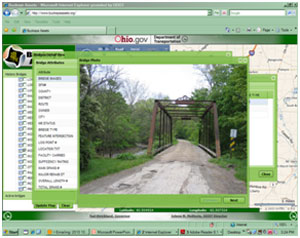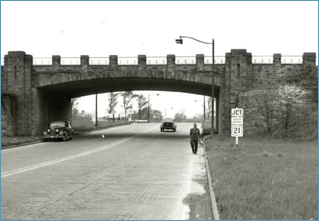OHIO DEPARTMENT OF TRANSPORTATION
Buckeye Assets Web Site
Program Description

Screenshot of BuckeyAssets web site.
(Source: Ohio Department of Transportation.)
Program Benefits
- County engineers, bridge owners, consultants, and Ohio DOT’s (ODOT) internal staff are able to identify the location of historic bridges early in the planning process.
- Existing and pending preservation plans will enable the State to target preventative maintenance of historic bridges under their jurisdiction.
- County engineers consider the reuse of historic bridges (when feasible) early in the planning stages.
Ohio DOT (ODOT) updated its statewide historic bridge inventory in 2009. This inventory was based, in part, on the report, “A Context for Common Historic Bridge Types” (NCHRP Project 25-25, Task 15 (2005)). Information on the State’s historic bridges, based on the 2009 inventory, is available on the Department’s recently launched on-line bridge web site, known as BuckeyeAssets.
The web site provides information on location, bridge type, dates of construction, historic context, and National Register eligibility evaluation, in addition to photographs and other documents. In some instances original construction plans are included.
Individual historic bridge management plans are accessible via this on-line tool. These plans provide guidance on how to best protect historic bridges, including proactive preservation measures as well as future rehabilitation efforts.
DOT has completed 13 management plans and is in the process of developing approximately 39 additional plans in collaboration with a team of historians and structural engineers.
Setting Up the Program
Program Elements
- Historic Preservation in Transportation Planning
- Historic Preservation in Early Project Development
- Geographic Information Systems
- Historic Property Database
- Programmatic Approaches to Identifying, Evaluating, and Managing Historic Properties
ODOT hired a consultant to develop the program. The program’s scope of work included:
- Converting all existing historic bridge data to a digital format;
- Creating an easy-to-use web-based system for accessing information on the bridges;
- Re-evaluating the approximately 500 historic bridges in the database;
- Attempting to locate off-system, abandoned, and moved historic bridges, and then evaluating their significance and adding these bridges to the database;
- Interviewing each county engineering office about their historic bridges and researching their records; and
- Creating new, updated inventory forms for all National Register eligible and listed bridges.
The development of this program was supported by the management staff of multiple offices within ODOT, including the Office of Environmental Services, the Office of Structural Engineering, and ODOT’s Information Technology department.
Challenges Encountered
The program was well-planned and well-funded. No major challenges were experienced in the development of the program. Communication, internally and externally, was key in avoiding potential challenges.
The ODOT team continually updated Federal Highway Administration (FHWA) and the State Historic Preservation Office (SHPO) on the progress of the program.
Numerous formal and informal discussions resulted in minor refinements along the way. In addition, ODOT’s Office of Environmental Services worked proactively with other internal DOT departments. This inclusive approach transformed the program into a dynamic working process.
Program Maintenance

Cuyahoga County, Cloverleaf Bridge, 1947.
(Source: Ohio Department of Transportation.)
Once the preservation plans are complete, the ODOT Office of Structural Engineering will be able to use the preservation plans and implement a preventative maintenance program for historic bridges under the State’s jurisdiction.
The Office of Structural Engineering will be able to allot a specific amount of funding to carry out the recommended maintenance. The first step, however, is to provide the bridge department information on historic bridge locations, in addition to recommended historic bridge maintenance activities so they may embed this information into their work program.
ODOT, the FHWA, and the Ohio SHPO support the program. ODOT presents a yearly historic bridge project award at the county engineer’s annual meeting, and provides the counties updated information on historic bridges on a continual basis.
Critical Factors for a Successful Program

Broad Street Bridge over
the Scioto River in Columbus, Ohio.
(Source: PhotoDisc, Inc.)
The success of the ODOT Historic Bridge Program is dependent on two critical factors:
- Open communication with agencies and bridge owners; and
- Support of the FHWA, ODOT, SHPO, and county engineers.
The ODOT Cultural Resources team will continue to work with agencies and bridge owners to identify alternatives to replacement.
Rehabilitation is recommended as an early consideration and guidance is provided to facilitate rehabilitation through the individual historic bridge management plans in the on-line bridge web site.
June 1, 2012
You will need the Adobe Reader to view the PDFs on this page.

